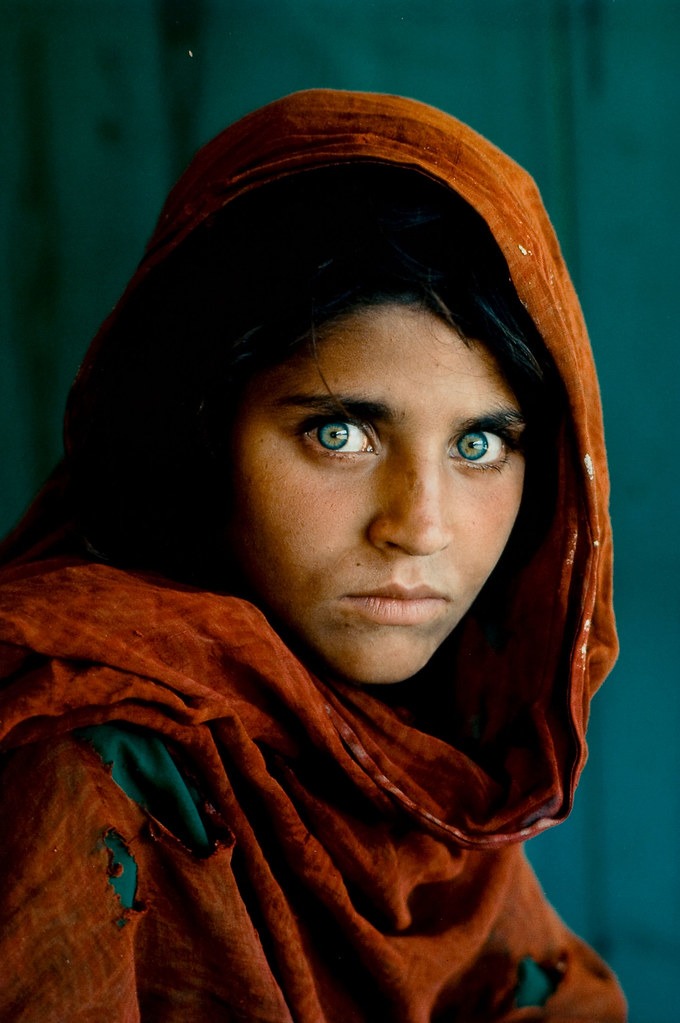The hidden truth behind the infamous National Geographic ‘Afghan Girl’ photo
Wrapped in a worn maroon shawl with piercing green eyes and a stare that penetrates the camera, Sharbat Gula’s portrait has become an iconic photograph. Whether or not you’re a regular reader of National Geographic, you’ve inevitably encountered this photo captured by Steven McCurry, famously known as the ‘Afghan Girl’, on the magazine’s June 1985 cover. However, astonishingly, Gula herself did not lay eyes on the photo until 17 years later.
In 1984, Steve McCurry worked as a National Geographic photojournalist in Pakistan amid the early years of the Soviet invasion in neighbouring Afghanistan. In one of his shoots, McCurry stepped into an all-girls Islamic religious school. Upon entering, he spotted twelve-year-old student Sharbat Gula’s eyes. Despite attempts to conceal her face, he requested her class teacher’s assistance in persuading her to cooperate. After being compelled to “let him photograph her… she lowered her hands” in McCurry’s own words. In a revealing 2002 interview, Gula expressed her emotions for the first time about the moment the photo was taken and disclosed that she “remembers her anger”.
Despite the substantial profits generated, Sharbat Gula received nothing
In the cultural context of traditional Pashtun norms, McCurry’s actions were deeply intrusive. It’s frowned upon for a girl to reveal her face, interact closely, establish eye contact, or be photographed by a man outside her family circle. The photo’s accompanying caption, “Haunted eyes tell of an Afghan refugee’s fears,” widely interpreted as a symbol of Afghan refugee distress, masks the probable unease and fear Gula felt towards McCurry during the shoot.
Named “the most recognised photograph” in National Geographic’s history, this image stands as one of the most globally identifiable photographic portraits ever captured, propelling Steve McCurry’s career into fame and recognition. The photograph’s immense popularity led to its sale for substantial amounts, with Steve McCurry Studios pricing their open edition 20″ x 24″ print of Sharbat Gula at $18,000, while larger prints fetched as much as $178,900 in auctions. However, despite the substantial profits generated, Sharbat Gula received nothing. It’s ironic that a photo meant to spotlight the plight of refugees resulted in the photographer reaping all the financial rewards for himself. “Photojournalism has been guilty of awful abuses through history, often exploiting the poor for profit”, says Tony Northrup, photographer and popular photo vlogger.
Gula’s experience, hidden behind the lens, reflects a larger issue surrounding the exploitation of powerful visual stories
National Geographic’s quest to find and identify the ‘Afghan Girl’ began 17 years after the photo’s capture, eventually confirming her identity as Sharbat Gula through iris recognition software. This resurgence of interest in the image prompts us to question the true motives behind the search. Was it genuinely aimed at aiding her, or was it an attempt to exploit her story for enhanced readership?
The latter appears more plausible, given the lack of improvement in her situation, culminating in her arrest in 2016 for using a forged Pakistani identity card, a common practice among the 1 million Afghan refugees residing in Pakistan without legal status.
Gula was paraded in front of television cameras, before being expelled to Kabul. “That photo created a lot of problems for me […] I would have preferred it had never been taken” says Gula. “I remember that day well, that photographer who arrived at the Nasir Bagh camp school. I was a child. I didn’t like photos. In Afghan culture, women do not appear in photos. But there wasn’t much choice.”
Seventeen years later, when her portrait was retaken, the only apparent change in her life was her age. Sharbat Gula’s experience, hidden behind the lens, reflects a larger issue surrounding the exploitation of powerful visual stories. Her narrative transcends a mere photograph; it’s about a life, a struggle, and the unfortunate consequences of a single snapshot.
The ‘Afghan Girl’
![Steve McCurry - Afghan Girl [1984] | Steve McCurry (born in … | Flickr](https://live.staticflickr.com/654/21411549214_e1c9837dc4_b.jpg)
Image: Flickr/Gandalf’s Gallery

Comments